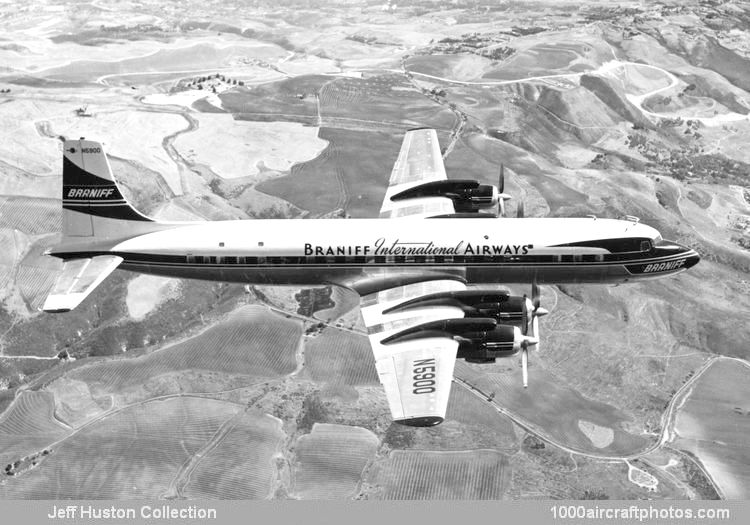To achieve the required range, span was increased 10 ft (3.05 m) to 127.6 ft (38.86 m) by adding sections between the fuselage and inner nacelles. This modification not only enabled total fuel to be increased from the DC-7B's capacity of 5,525 gal (20,914 l) to 7,825 gal (29,620 l) but also moved the engines further outboard to reduce noise and vibration in the passenger cabins, an important consideration for long flights. Furthermore, the fuselage length was further increased by 39.8 in (1.01 m) to a total of 112 ft 3 in (34.21 m). Maximum gross take off weight was increased from the DC-7B's capacity of 126,000 lb (57,153 kg) to 143,000 lb (64,864 kg) and all DC-7Cs were powered by 3,400 hp Wright R-3350-18EA-1 eighteen-cylinder air-cooled radial engines, driving four-blade propellers.
The prototype Seven Seas (N70C c/n 44872) was flown on 20 December, 1955, and Pan American introduced the type into service on June 1, 1956. A total of 121 DC-7Cs were sold to US and foreign airlines and, after being phased out of passenger service, many were converted as freighters.
The pictured aircraft was the first of seven DC-7Cs (registered N5900 to N5906 c/n 45068 to 45074) ordered by Braniff on March 17, 1955, and was accepted and named El Dorado at Santa Monica, California, on September 9, 1956. It arrived at the Braniff Operations and Maintenance Base at Dallas Love Field, Texas, on September 13, 1956. Subsequently it was used in a month-long introduction extravaganza of VIP and inauguration flights.
On September 14, 1960, N5900 was taxied by a ground qualified inspector from the hangar to the maintenance run up area at Dallas Love Field to test its engines. Taxiing the aircraft with the hydraulic system in 'bypass' caused the aircraft to lose its braking ability and it struck the front of a building, causing serious damage to the forward fuselage. The inspector sustained serious injuries and died, five other occupants survived. Subsequently the aircraft was repaired and returned to service.
Braniff withdrew the DC-7C fleet from service on December 1, 1966, and the aircraft were stored at Dallas Love Field. Many of the aircraft remained on Braniff's Base as late as 1970, before new owners bought the aircraft.
N5900 was sold to the Air Travel Club of New York on February 20, 1968, however, Braniff repossessed the aircraft for non-payment on June 1, 1968. After six weeks storage at Dallas Love Field, it was sold to Dallas Aero Service on July 12, 1968. Note the following dates referring to ownership of the N5900 are the issue dates of the related bi-annual register issue, the actual entry in the FAA register might have been made up to six months earlier.
|
1970 Jan. 1 |
Club America, Dallas, Texas |
